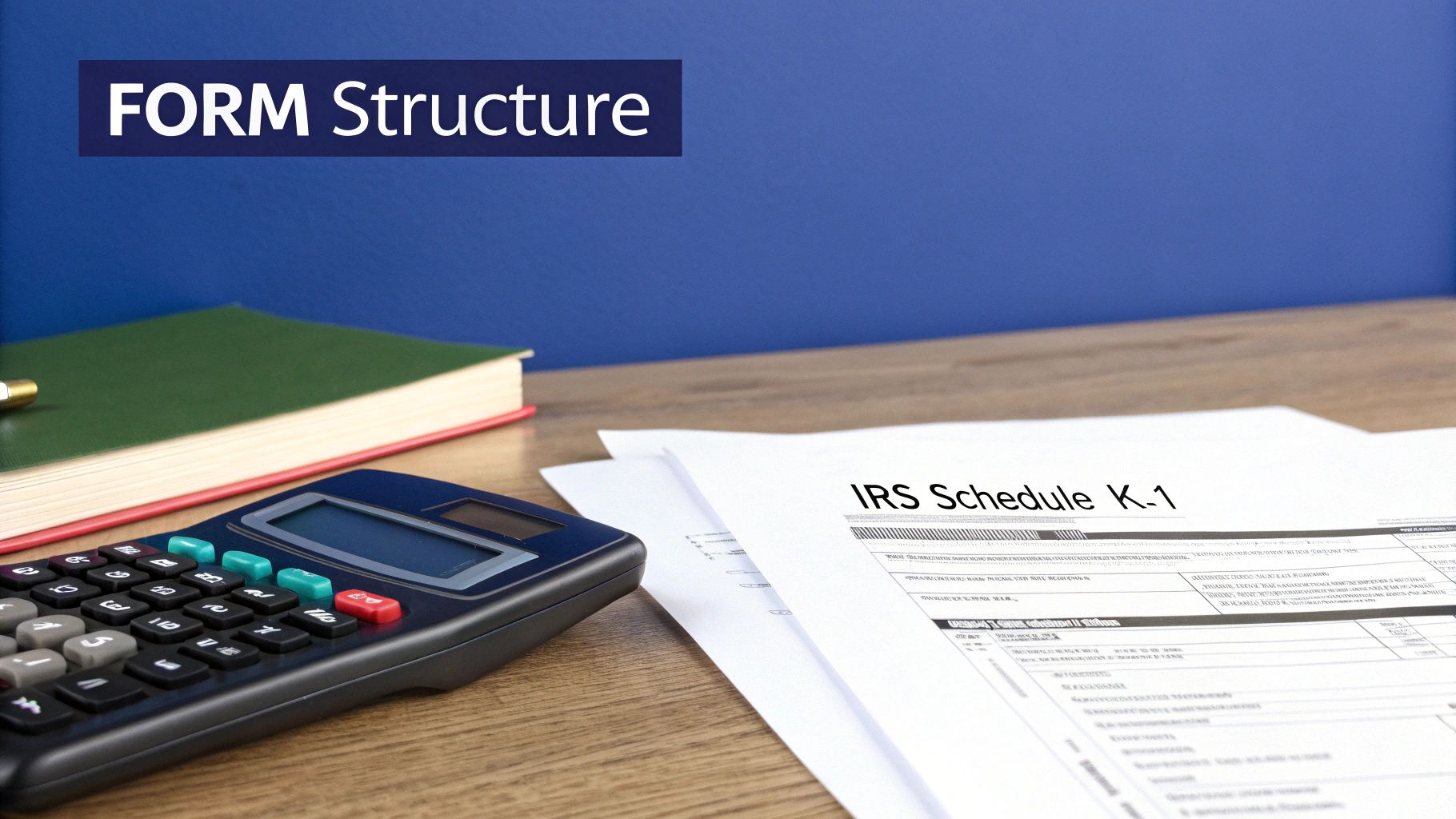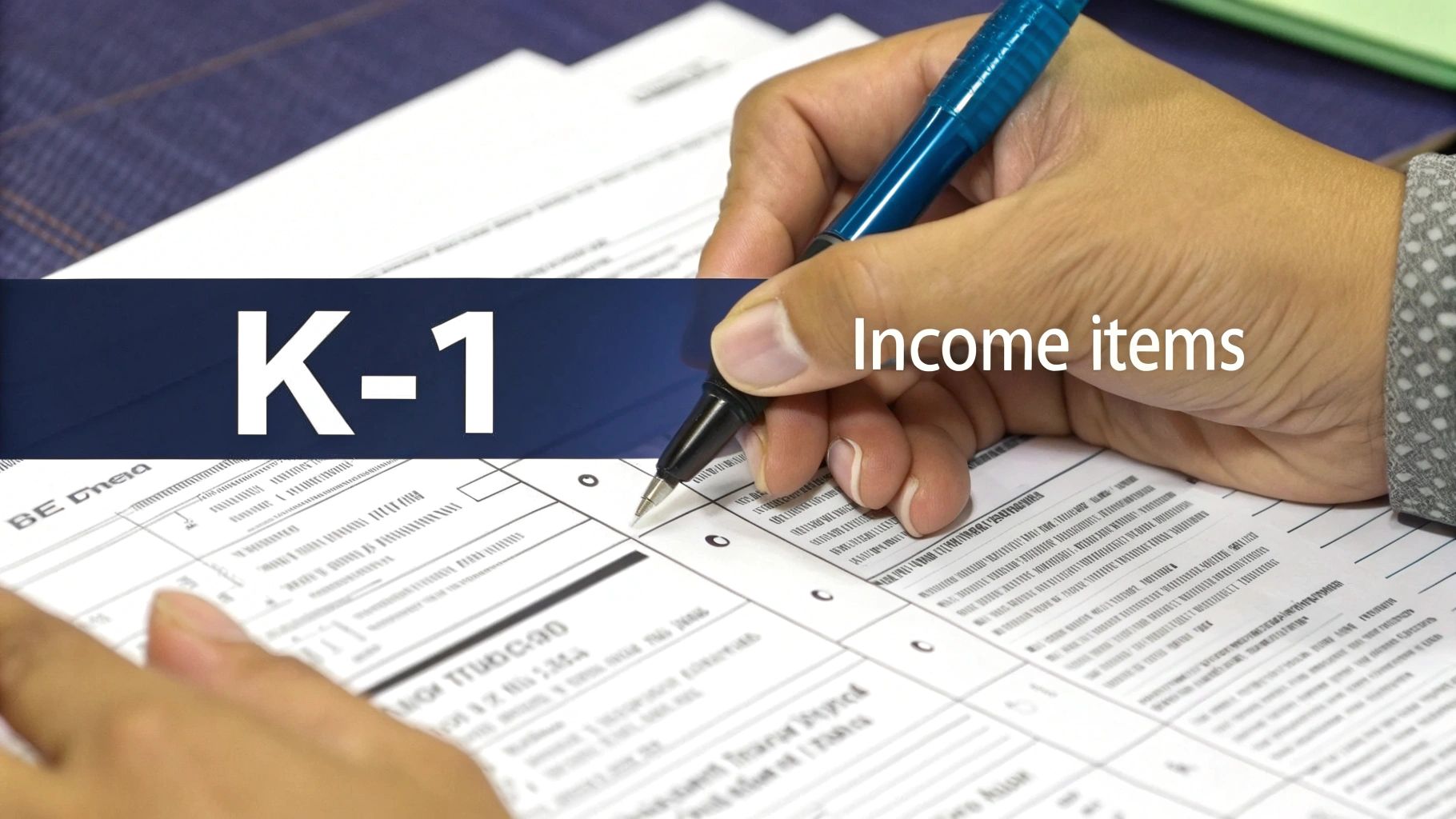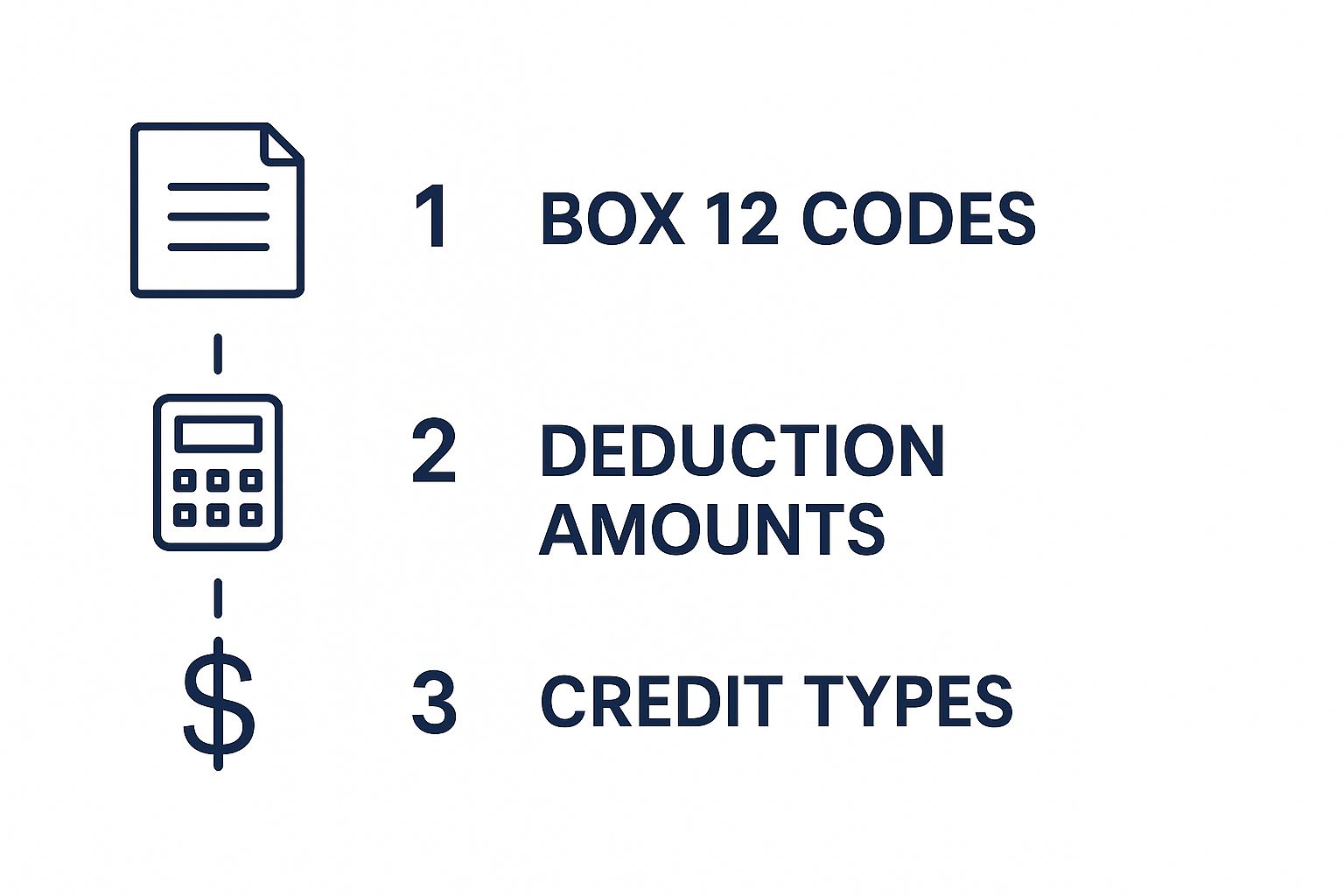How to Read a K-1: A Guide for Real Estate Investors
- Ryan McDowell

- Aug 21
- 13 min read
Reading Time: 8 min | Good for: Novice (A), Informed (B)
TL;DR: Your Guide to the K-1
What it is: A Schedule K-1 is an IRS form that reports your share of income, deductions, and credits from a partnership investment, like a private real estate deal. It connects the partnership's tax return to your personal return.
Why it matters: Unlike a simple 1099, the K-1 provides the detailed numbers you and your CPA need to report investment performance accurately and take advantage of tax benefits like depreciation.
Key takeaway: The cash distributions you receive (Box 19) are often not the same as your taxable income (Boxes 1-3). Powerful deductions frequently create a "paper loss" for tax purposes, shielding your cash flow.
Next step: The details are in the footnotes. Always give the complete K-1 package, including all supplemental statements, to your tax advisor to ensure you capture every available benefit.
When you first receive a Schedule K-1, it can feel a bit like you’ve been handed a complex puzzle. But it’s simply the financial language of partnership investing. This document is critical because it breaks down your specific share of a partnership's income, deductions, and credits for the tax year.
Think of it as the Rosetta Stone for your investment—it translates the property's financial performance into the exact numbers you'll need for your personal tax return. Understanding it is a key step in moving from a passive investor to an empowered partner in your own wealth strategy.
Your First Look at the Schedule K-1
If you've allocated capital to a private real estate deal structured as a Limited Partnership (LP) or Limited Liability Company (LLC), you can expect to receive a Schedule K-1. Why? Because these are "pass-through" entities.
Unlike a C-corporation that pays its own corporate taxes, these partnerships pass their financial results directly through to the investors. The K-1 is the bridge connecting the partnership's master tax return (typically an IRS Form 1065) to your personal Form 1040. Its job is to report your slice of the financial pie so you can report it accurately to the IRS.
Getting comfortable with this form is a must for any serious investor. And it's not a niche document—the IRS reports that millions of K-1 forms are issued annually, highlighting just how common this investment structure is for those seeking access to private markets.

The Three Main Parts of a K-1
It’s helpful to think of the K-1 as a three-act story about your investment's performance for the year. Breaking it down this way makes it far less intimidating.
Part I - Partnership Information: This is the basic "who's who." It provides general information about the investment entity itself—its name, address, and Employer Identification Number (EIN).
Part II - Partner Information: Here, the spotlight turns to you. This section details your personal information, your ownership stake (usually shown as a percentage), and a crucial summary of your capital account.
Part III - Partner's Share of Current Year Items: This is the heart of the document. It's the most detailed part, breaking down your share of specific income types, deductions (like depreciation), and any tax credits.
Before we dive into the specific boxes and codes, it's worth knowing which type of K-1 you're holding, as different entities use different versions.
Quick Guide to Common K-1 Forms
Here’s a simple table that breaks down the different K-1s you might encounter.
K-1 Type | Associated IRS Form | Entity Type | Common Use in Real Estate |
|---|---|---|---|
Form 1065 K-1 | Form 1065 | Partnership (LP, LLC) | This is the one you'll see 99% of the time for private real estate syndications and funds. |
Form 1120-S K-1 | Form 1120-S | S Corporation | Less common for holding real estate directly, but you might see it if an operating company is part of the deal structure. |
Form 1041 K-1 | Form 1041 | Estate or Trust | You'd receive this if you are a beneficiary of a trust that holds real estate assets. |
In the world of passive real estate investing, you'll almost always be dealing with the K-1 from a Form 1065. Now, let’s get into the nitty-gritty of what each box means for you.
Getting the Basics Right in Part I and II
Before jumping into the numbers in Part III, treat Parts I and II like a pre-flight checklist. This quick but essential step confirms all the foundational details are correct. A small mistake here can cause major headaches with the IRS, so let's ensure everything is in order.
Think of these first two sections as your anchor, grounding the entire document by verifying the investment entity and your personal stake in it.
First up is Part I, "Information About the Partnership." This part is straightforward. You'll see the partnership’s name, address, and the all-important Employer Identification Number (EIN). Take a moment to cross-reference these details with your original subscription documents. It’s a simple check that confirms you're looking at the right K-1 for the right deal.

Making Sure It's Your Stake in Part II
Now, we shift to Part II, "Information About the Partner." This section is all about you. Double-check that your name, address, and Social Security Number (or EIN, if applicable) are spot-on. Even a minor typo can create a mismatch with IRS records and cause unnecessary delays.
The real substance of this section, however, is in a few key boxes that define your financial relationship with the partnership.
Item K: Here you'll find your percentage share of the deal's profit, loss, and capital—at both the beginning and end of the year. These percentages are the drivers that allocate the partnership's financial activity to your personal tax return.
Item L: This shows your share of the partnership’s liabilities. This number is more important than it might seem, as it's a critical component of your tax basis, which directly impacts how much in losses you can deduct.
The centerpiece of Part II is Item J: Partner’s Capital Account Analysis. This small table provides a powerful summary of your financial journey with the investment for the year. It shows your starting capital, any new contributions, your share of the year's income or loss, any cash distributions you received, and your final capital balance. It’s the clearest snapshot you'll get of how your ownership stake changed over the last twelve months.
Novice Lens: Think of your capital account as a bank account just for this investment. Your contributions are deposits, your share of income grows the balance, and distributions are withdrawals. The ending balance shows what your stake is worth on the partnership's books.
For more experienced investors, how this capital account is calculated is a critical detail.
Advanced Lens: Look for the checkbox in Item J. It specifies if the capital account is reported on a tax basis, GAAP, Section 704(b), or another method. The difference has real tax implications. A tax basis capital account is crucial—it reflects your after-tax investment and dictates the consequences of distributions and your ultimate gain or loss on sale. A 704(b) basis, on the other hand, reflects the pure economic arrangement between partners. If these two numbers differ, it often signals complex tax allocations that warrant a conversation with your CPA to ensure your tax position is optimized.
Breaking Down Your Share of Income and Deductions in Part III
Part III is the heart of your K-1. This is where the partnership's financial activity is distilled into the exact numbers that will flow to your personal tax return. Let’s walk through the boxes that matter most to real estate investors.
These figures tell the story of your investment's performance. Understanding them is key to seeing how your capital is working and, just as importantly, how it's impacting your tax situation.
Decoding Income Boxes 1 Through 3
The first three boxes in Part III are all about income, but the IRS treats each type differently.
Box 1 - Ordinary Business Income (Loss): This applies when a partnership runs an active trade or business. For a straightforward rental property, it's less common. However, if the partnership is involved in development or has significant operational components, you might find a number here.
Box 2 - Net Rental Real Estate Income (Loss): This is the main event for most passive real estate investors. It shows the profit or loss from the property's rental operations (rental income minus direct operating expenses), but before non-cash deductions like depreciation.
Box 3 - Other Net Rental Income (Loss): This is similar to Box 2 but applies to rental income from assets that are not buildings, like equipment rentals.
A positive number in Box 2 is a great sign; it means the property is generating positive cash flow. But don't be surprised to see a loss, especially in the early years of a project. That's where the tax advantages of real estate truly shine.
Deal Lens Example: The Multifamily Investment Let's say you invested in a Stiltsville Capital multifamily value-add project. In the first year, your share of the net rental income (Box 2) is a solid $5,000. But the partnership executed an aggressive depreciation strategy, giving you a -$12,000 depreciation deduction (detailed in Box 13). This flips your taxable rental income into a -$7,000 "paper loss." You received cash flow, but for tax purposes, you have a loss that can potentially offset other passive income.
This classic scenario demonstrates why real estate is so tax-efficient. The cash you receive is often shielded by non-cash expenses. It's a fundamental concept we explore in our guide on how to maximize your returns with real estate tax benefits.
Understanding Deductions in Box 13
Box 13 is where many of the powerful tax deductions are detailed using a series of letter codes. Your tax advisor will translate these into the right spots on your return. It can look cryptic, but for real estate, a few common codes appear frequently.
This infographic shows how these codes flow through to your final deductions.

As you can see, the codes in Box 13 are a roadmap pointing to where various deductions and credits originate.
Here are the codes you'll most likely encounter:
Code H - Depreciation: This is a major one. It represents your share of the non-cash write-off for the property's wear and tear. Depreciation is the engine that fuels the "paper losses" that make real estate investing so attractive from a tax perspective.
Code J - Section 179 Deduction: This allows the partnership to expense the entire cost of certain equipment in the year it was purchased.
Code K - Deductions–Portfolio: This is a bucket for portfolio-related deductions, typically investment expenses not tied directly to the property's day-to-day operations.
These codes are your ticket to lowering your taxable income. A crucial tip: always ensure the supplemental statements accompanying your K-1 get to your CPA. They contain the all-important details behind these coded numbers.
Understanding Distributions vs. Taxable Income
One of the first things that trips up new investors is the gap between the cash that hits their bank account and the income they report to the IRS. They are almost never the same number, and understanding why is the secret to appreciating the tax efficiency of private real estate.
The cash you receive from a deal is called a distribution, which is a completely separate concept from your taxable income.

Box 19 Distributions Explained
On your K-1, cash distributions are reported in Box 19, Code A. It’s easy to see a number there and think, "Great, here's more income I owe tax on." But that’s usually not the case.
More often than not, that distribution is considered a non-taxable return of capital. It’s a formal way of saying the investment is giving you a piece of your original money back. It’s not a profit; it’s a return of your principal.
Because it's not "income" in the eyes of the IRS, it's generally not taxed in the year you receive it. What it does do is reduce your tax basis in the investment.
Key Takeaway: Distributions are cash in your pocket. Taxable income is what the IRS sees. In real estate, powerful deductions like depreciation often mean your taxable income is far less than the cash distributions you receive—sometimes it's even a loss.
The Critical Role of Your Tax Basis
Think of your tax basis as the official scorecard for your after-tax investment in a deal. It's a number you must track over the entire life of the investment.
Here’s how it works. Your basis starts with your initial investment. Then, it changes every year:
It increases by your share of the partnership's taxable income.
It decreases by your share of any partnership losses.
It also decreases by every dollar of cash distributions you receive.
Keeping a running tally of your basis is non-negotiable. Why? Because it ultimately determines your capital gain or loss when the property is sold. A lower basis means a bigger taxable gain down the road.
At-Risk Rules and Loss Limitations
While generating paper losses from real estate is a fantastic tax-saving tool, the IRS has guardrails in place. The "at-risk" rules, referenced in Part II, Item K, generally limit the losses you can deduct. Your deductible losses cannot exceed the amount you personally have "at risk" in the investment, which includes your cash contributions and certain types of debt.
This is another reason why tracking your basis is so vital. Your basis calculation is a key part of determining if you have a sufficient at-risk amount to use the full partnership losses reported on your K-1.
Investor Checklist: Questions to Ask a Sponsor
Getting ahead of tax season confusion is always a good idea. A few proactive questions for the sponsor can save a lot of headaches for you and your CPA.
Reporting Method: "What method are you using for reporting capital accounts—is it tax basis, 704(b), or another method?"
Timeline: "What is your target date for distributing K-1s to investors?"
CPA Communication: "If my CPA has clarifying questions, is your accounting team available to assist?"
State Filings: "Will the partnership be filing in multiple states? I need to determine if I'll have any non-resident state filing requirements."
Cracking the Code: Why K-1 Footnotes Are Where the Real Action Is
If you only look at the first page of your Schedule K-1, you're missing half the story. The real substance—the context behind every number—is tucked away in the attached statements and footnotes. For any serious investor, learning to read these supplemental pages is a non-negotiable skill.
Think of it this way: the numbered boxes on the main form give you the "what." The attached statements tell you the crucial "why" and "how." Skipping them is like reading chapter titles and assuming you know the plot. These pages are where the sponsor breaks down the complex calculations your CPA needs to file your taxes correctly.
What’s with All the Codes in Boxes 13, 17, and 20?
You'll notice that several boxes, especially Box 13 (Credits & Deductions), Box 17 (Self-Employment), and Box 20 (Other Information), are filled with cryptic letter codes. This is simply IRS shorthand. The attached statements are your decoder ring, listing each code with its corresponding dollar amount and a clear description.
Box 13 Codes: This is where you'll find the details on items like investment interest expense, charitable contributions, or specific tax credits. The statement breaks down precisely what makes up those totals.
Box 20 Codes: This is a catch-all for important details. One of the most common codes here is Code Z, which almost always relates to the Section 199A Qualified Business Income (QBI) deduction. The statement will provide the exact income, wage, and property basis figures needed to calculate this powerful deduction.
Without these detailed statements, your tax preparer is flying blind. They need this granular information to correctly report everything on your personal tax return.
Investor Takeaway: Always, always provide your tax advisor with the entire K-1 package, not just the first page. The supplemental information isn't optional—it's essential for filing your taxes correctly and ensuring you don’t leave money on the table.
Interestingly, the ability to parse these dense financial documents starts with cognitive skills we build as children. A report from Market Data Forecast on the interactive children's book market, projected to hit USD 1.065 billion by 2033 (as of 2023), illustrates how foundational comprehension is developed. Just as a child learns to connect words to concepts, an investor learns to connect a K-1 code to a specific tax outcome using the attached statements.
When you understand these footnotes, you can have a much smarter, more strategic conversation with your CPA. You’re no longer just handing over a form; you're actively discussing strategy and ensuring every tax benefit your investment was designed to deliver is being captured.
Common Questions About Schedule K-1
Even after a line-by-line review, a few practical questions almost always pop up once an investor has a K-1 in hand. That’s perfectly normal. Here are the most common questions we hear, with straightforward answers.
Why Did I Get a K-1 Instead of a 1099?
This is a classic question. You receive a K-1 because you are a partner in an entity (like an LLC or LP) that "passes through" its financial results directly to its owners. This structure is standard in private real estate because it avoids the double taxation that corporations face. A Form 1099 is much simpler; it’s for reporting direct payments like interest or contractor fees. A Schedule K-1 is a detailed breakdown of your specific share of a partnership's complete financial picture.
My K-1 Shows a Loss, But I Received Cash. Why?
This is the most common (and best) scenario for a real estate investor. The K-1 shows a "paper loss" driven primarily by large, non-cash deductions like depreciation. The cash you received in your bank account (reported in Box 19) is a separate event. It’s often treated as a non-taxable return of your own capital.
Investor Takeaway: This isn't a mistake; it's a feature. This is how depreciation works to shield your cash flow from immediate taxation, which is a cornerstone of tax-efficient real estate investing.
When Should I Expect to Receive My K-1?
Partnerships are generally required to file their tax returns by March 15th, or by September 15th if they file for an extension. You should typically expect your K-1 between late February and late March. However, it’s not unusual for K-1s from complex deals to arrive later. This is why most experienced passive investors plan on filing an extension for their personal taxes every year. It removes the stress and ensures accuracy.
What Common Mistakes Should I Avoid?
The biggest mistakes we see investors make usually fall into three categories:
Confusing Cash with Income: Never assume the cash distribution in Box 19 is the same as the taxable income (or loss) in Boxes 1-3.
Ignoring the Statements: Forgetting to give your CPA the supplemental statements and footnotes is a critical error. Those pages contain essential details.
Forgetting Basis Adjustments: Not tracking your investment's tax basis year after year. This is absolutely essential for correctly calculating your capital gains when the asset is eventually sold.
Understanding how different investment structures impact your K-1 is also important. For instance, tax treatment can differ based on your position in the capital stack. A deeper dive into topics like what preferred equity is and how it works for real estate investors can provide additional clarity.
At Stiltsville Capital, we believe well-structured real assets can be a prudent, resilient component of a long-term wealth strategy. A well-informed investor is a successful one, and we are committed to providing the transparency you need to make confident decisions.
If you have more questions or want to explore how our institutional-grade real estate offerings can fit into your portfolio, schedule a confidential call with our team. https://www.stiltsvillecapital.com
Information presented is for educational purposes only and does not constitute an offer to sell or a solicitation of an offer to buy securities. Any offering is made only through definitive offering documents (e.g., private placement memorandum, subscription agreement) and is available solely to investors who meet applicable suitability standards, including “Accredited Investor” status under Rule 501 of Regulation D. Investments in private real estate involve risk, including loss of capital, illiquidity, and no guarantee of distributions. Past performance is not indicative of future results.





Comments